Sustainable Leadership: A Transformational Change for Individuals
VerifiedAdded on 2022/09/15
|9
|2775
|15
Report
AI Summary
This paper delves into the concept of sustainable leadership, exploring its role in driving transformational change. It begins by defining sustainable leadership and examining relevant leadership theories, emphasizing the importance of contextual and relational leadership. The paper introduces the Cambridge Sustainability Leadership Model and outlines key characteristics of sustainable leaders, including moral drive, holistic thinking, open-mindedness, empathy, and courage. Different leadership styles are discussed, along with the skills necessary for a sustainable economy, such as complexity management and vision communication. The paper highlights the importance of these attributes in fostering effective leadership and driving sustainable practices across various sectors.
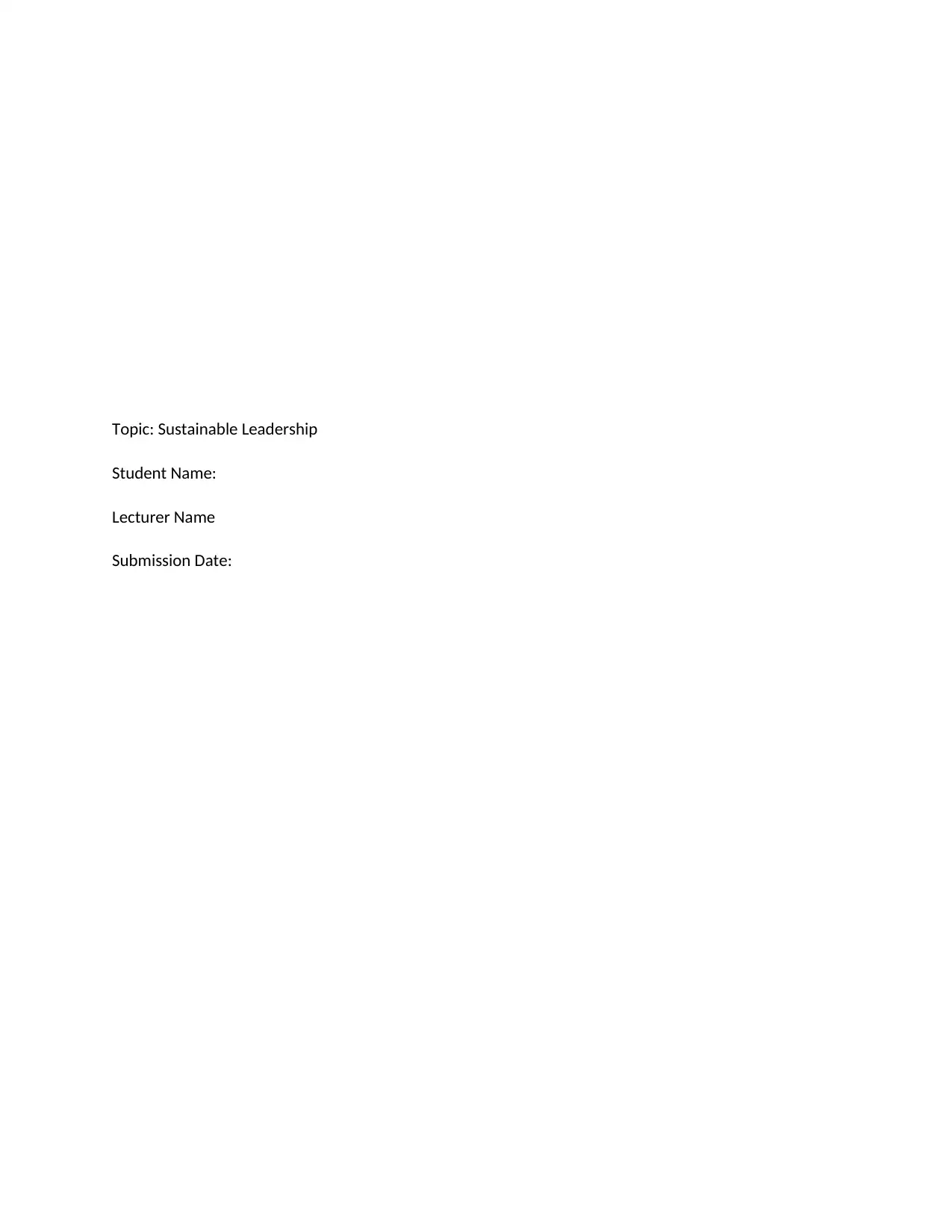
Topic: Sustainable Leadership
Student Name:
Lecturer Name
Submission Date:
Student Name:
Lecturer Name
Submission Date:
Paraphrase This Document
Need a fresh take? Get an instant paraphrase of this document with our AI Paraphraser
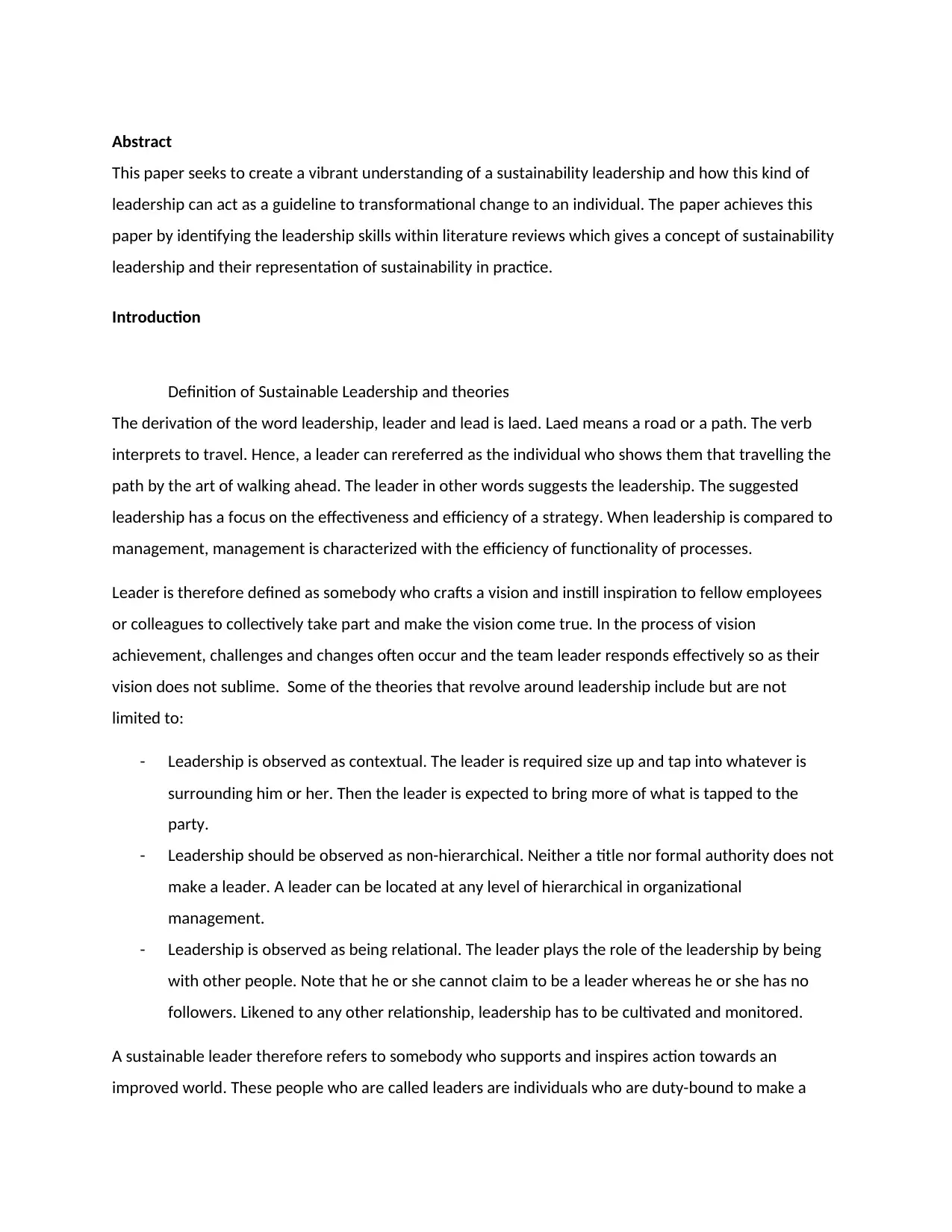
Abstract
This paper seeks to create a vibrant understanding of a sustainability leadership and how this kind of
leadership can act as a guideline to transformational change to an individual. The paper achieves this
paper by identifying the leadership skills within literature reviews which gives a concept of sustainability
leadership and their representation of sustainability in practice.
Introduction
Definition of Sustainable Leadership and theories
The derivation of the word leadership, leader and lead is laed. Laed means a road or a path. The verb
interprets to travel. Hence, a leader can rereferred as the individual who shows them that travelling the
path by the art of walking ahead. The leader in other words suggests the leadership. The suggested
leadership has a focus on the effectiveness and efficiency of a strategy. When leadership is compared to
management, management is characterized with the efficiency of functionality of processes.
Leader is therefore defined as somebody who crafts a vision and instill inspiration to fellow employees
or colleagues to collectively take part and make the vision come true. In the process of vision
achievement, challenges and changes often occur and the team leader responds effectively so as their
vision does not sublime. Some of the theories that revolve around leadership include but are not
limited to:
- Leadership is observed as contextual. The leader is required size up and tap into whatever is
surrounding him or her. Then the leader is expected to bring more of what is tapped to the
party.
- Leadership should be observed as non-hierarchical. Neither a title nor formal authority does not
make a leader. A leader can be located at any level of hierarchical in organizational
management.
- Leadership is observed as being relational. The leader plays the role of the leadership by being
with other people. Note that he or she cannot claim to be a leader whereas he or she has no
followers. Likened to any other relationship, leadership has to be cultivated and monitored.
A sustainable leader therefore refers to somebody who supports and inspires action towards an
improved world. These people who are called leaders are individuals who are duty-bound to make a
This paper seeks to create a vibrant understanding of a sustainability leadership and how this kind of
leadership can act as a guideline to transformational change to an individual. The paper achieves this
paper by identifying the leadership skills within literature reviews which gives a concept of sustainability
leadership and their representation of sustainability in practice.
Introduction
Definition of Sustainable Leadership and theories
The derivation of the word leadership, leader and lead is laed. Laed means a road or a path. The verb
interprets to travel. Hence, a leader can rereferred as the individual who shows them that travelling the
path by the art of walking ahead. The leader in other words suggests the leadership. The suggested
leadership has a focus on the effectiveness and efficiency of a strategy. When leadership is compared to
management, management is characterized with the efficiency of functionality of processes.
Leader is therefore defined as somebody who crafts a vision and instill inspiration to fellow employees
or colleagues to collectively take part and make the vision come true. In the process of vision
achievement, challenges and changes often occur and the team leader responds effectively so as their
vision does not sublime. Some of the theories that revolve around leadership include but are not
limited to:
- Leadership is observed as contextual. The leader is required size up and tap into whatever is
surrounding him or her. Then the leader is expected to bring more of what is tapped to the
party.
- Leadership should be observed as non-hierarchical. Neither a title nor formal authority does not
make a leader. A leader can be located at any level of hierarchical in organizational
management.
- Leadership is observed as being relational. The leader plays the role of the leadership by being
with other people. Note that he or she cannot claim to be a leader whereas he or she has no
followers. Likened to any other relationship, leadership has to be cultivated and monitored.
A sustainable leader therefore refers to somebody who supports and inspires action towards an
improved world. These people who are called leaders are individuals who are duty-bound to make a
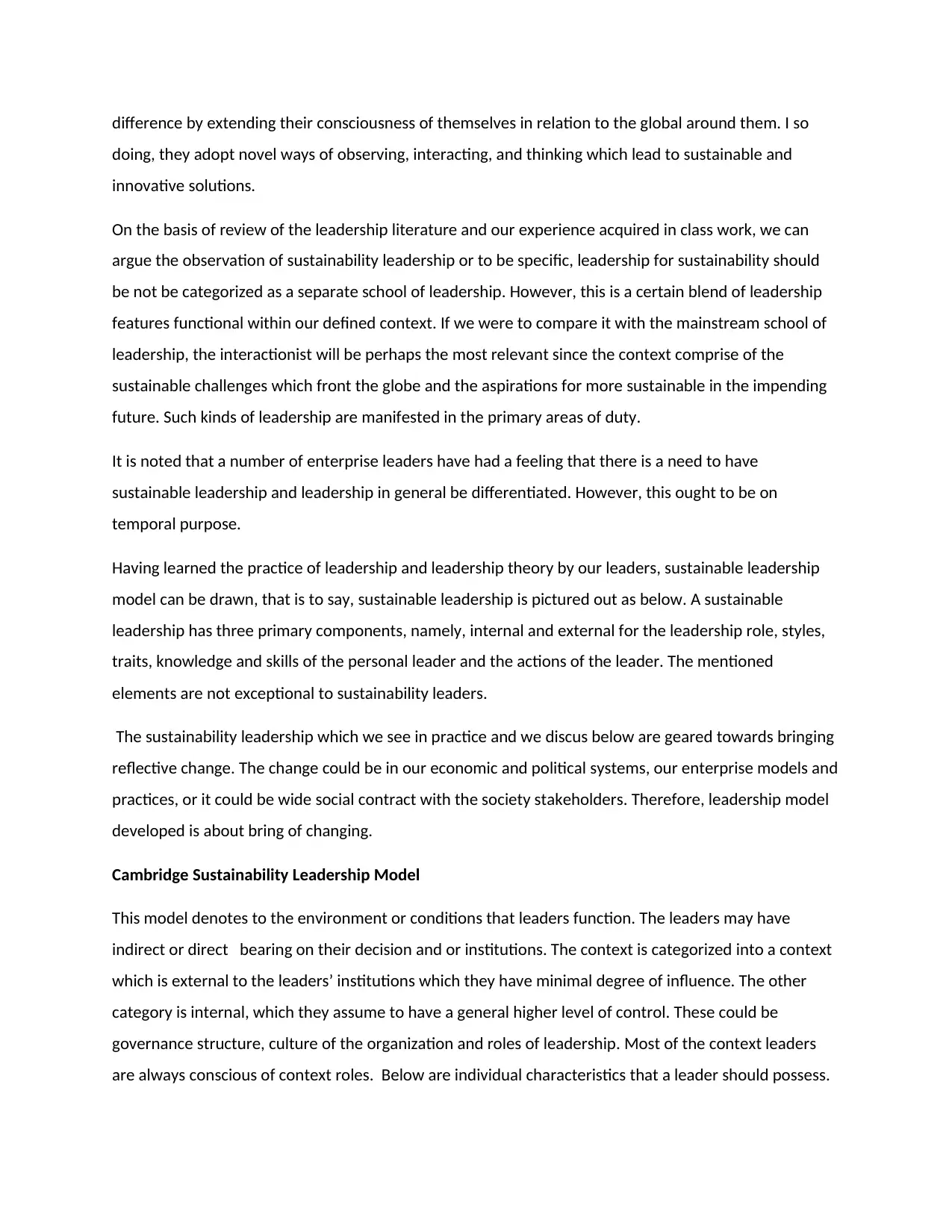
difference by extending their consciousness of themselves in relation to the global around them. I so
doing, they adopt novel ways of observing, interacting, and thinking which lead to sustainable and
innovative solutions.
On the basis of review of the leadership literature and our experience acquired in class work, we can
argue the observation of sustainability leadership or to be specific, leadership for sustainability should
be not be categorized as a separate school of leadership. However, this is a certain blend of leadership
features functional within our defined context. If we were to compare it with the mainstream school of
leadership, the interactionist will be perhaps the most relevant since the context comprise of the
sustainable challenges which front the globe and the aspirations for more sustainable in the impending
future. Such kinds of leadership are manifested in the primary areas of duty.
It is noted that a number of enterprise leaders have had a feeling that there is a need to have
sustainable leadership and leadership in general be differentiated. However, this ought to be on
temporal purpose.
Having learned the practice of leadership and leadership theory by our leaders, sustainable leadership
model can be drawn, that is to say, sustainable leadership is pictured out as below. A sustainable
leadership has three primary components, namely, internal and external for the leadership role, styles,
traits, knowledge and skills of the personal leader and the actions of the leader. The mentioned
elements are not exceptional to sustainability leaders.
The sustainability leadership which we see in practice and we discus below are geared towards bringing
reflective change. The change could be in our economic and political systems, our enterprise models and
practices, or it could be wide social contract with the society stakeholders. Therefore, leadership model
developed is about bring of changing.
Cambridge Sustainability Leadership Model
This model denotes to the environment or conditions that leaders function. The leaders may have
indirect or direct bearing on their decision and or institutions. The context is categorized into a context
which is external to the leaders’ institutions which they have minimal degree of influence. The other
category is internal, which they assume to have a general higher level of control. These could be
governance structure, culture of the organization and roles of leadership. Most of the context leaders
are always conscious of context roles. Below are individual characteristics that a leader should possess.
doing, they adopt novel ways of observing, interacting, and thinking which lead to sustainable and
innovative solutions.
On the basis of review of the leadership literature and our experience acquired in class work, we can
argue the observation of sustainability leadership or to be specific, leadership for sustainability should
be not be categorized as a separate school of leadership. However, this is a certain blend of leadership
features functional within our defined context. If we were to compare it with the mainstream school of
leadership, the interactionist will be perhaps the most relevant since the context comprise of the
sustainable challenges which front the globe and the aspirations for more sustainable in the impending
future. Such kinds of leadership are manifested in the primary areas of duty.
It is noted that a number of enterprise leaders have had a feeling that there is a need to have
sustainable leadership and leadership in general be differentiated. However, this ought to be on
temporal purpose.
Having learned the practice of leadership and leadership theory by our leaders, sustainable leadership
model can be drawn, that is to say, sustainable leadership is pictured out as below. A sustainable
leadership has three primary components, namely, internal and external for the leadership role, styles,
traits, knowledge and skills of the personal leader and the actions of the leader. The mentioned
elements are not exceptional to sustainability leaders.
The sustainability leadership which we see in practice and we discus below are geared towards bringing
reflective change. The change could be in our economic and political systems, our enterprise models and
practices, or it could be wide social contract with the society stakeholders. Therefore, leadership model
developed is about bring of changing.
Cambridge Sustainability Leadership Model
This model denotes to the environment or conditions that leaders function. The leaders may have
indirect or direct bearing on their decision and or institutions. The context is categorized into a context
which is external to the leaders’ institutions which they have minimal degree of influence. The other
category is internal, which they assume to have a general higher level of control. These could be
governance structure, culture of the organization and roles of leadership. Most of the context leaders
are always conscious of context roles. Below are individual characteristics that a leader should possess.
⊘ This is a preview!⊘
Do you want full access?
Subscribe today to unlock all pages.

Trusted by 1+ million students worldwide
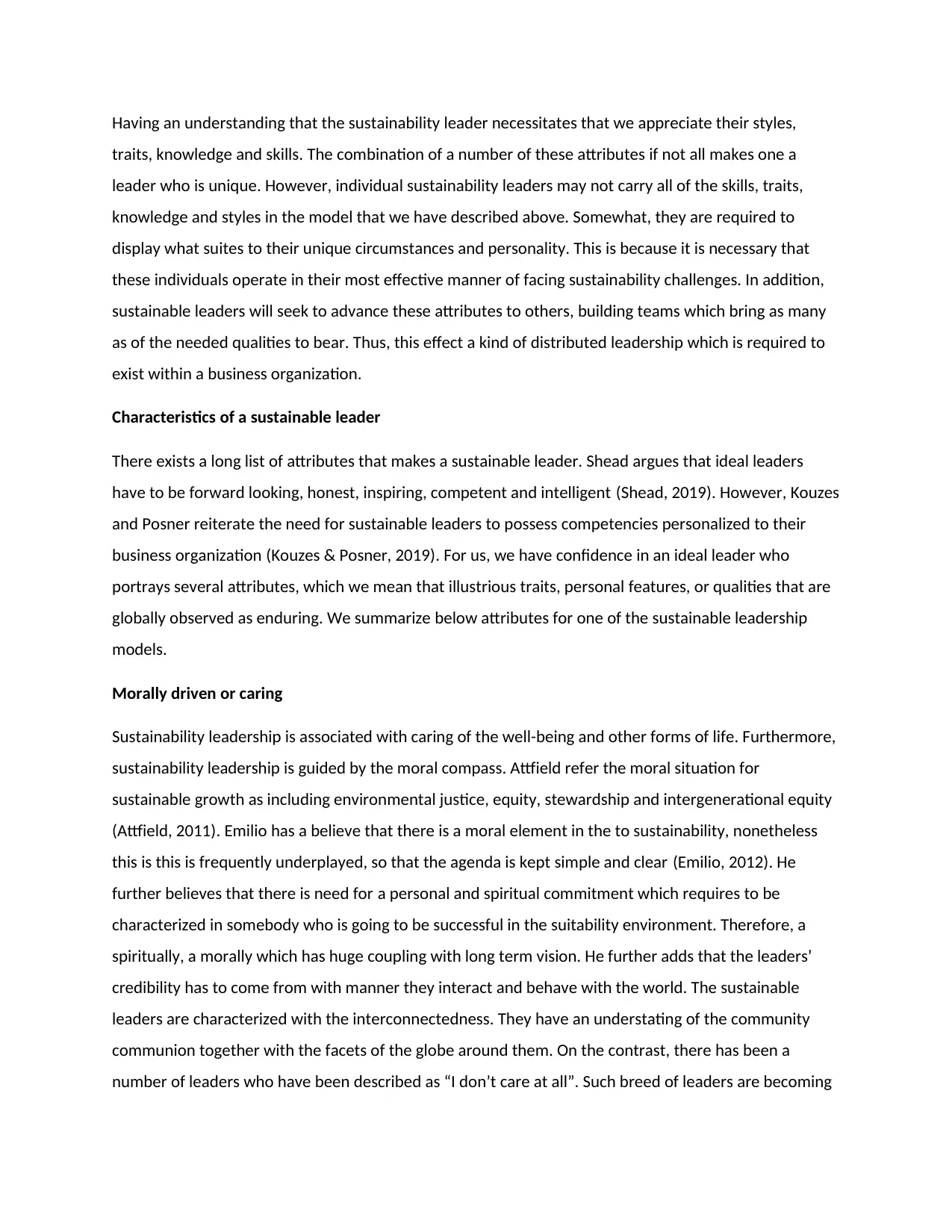
Having an understanding that the sustainability leader necessitates that we appreciate their styles,
traits, knowledge and skills. The combination of a number of these attributes if not all makes one a
leader who is unique. However, individual sustainability leaders may not carry all of the skills, traits,
knowledge and styles in the model that we have described above. Somewhat, they are required to
display what suites to their unique circumstances and personality. This is because it is necessary that
these individuals operate in their most effective manner of facing sustainability challenges. In addition,
sustainable leaders will seek to advance these attributes to others, building teams which bring as many
as of the needed qualities to bear. Thus, this effect a kind of distributed leadership which is required to
exist within a business organization.
Characteristics of a sustainable leader
There exists a long list of attributes that makes a sustainable leader. Shead argues that ideal leaders
have to be forward looking, honest, inspiring, competent and intelligent (Shead, 2019). However, Kouzes
and Posner reiterate the need for sustainable leaders to possess competencies personalized to their
business organization (Kouzes & Posner, 2019). For us, we have confidence in an ideal leader who
portrays several attributes, which we mean that illustrious traits, personal features, or qualities that are
globally observed as enduring. We summarize below attributes for one of the sustainable leadership
models.
Morally driven or caring
Sustainability leadership is associated with caring of the well-being and other forms of life. Furthermore,
sustainability leadership is guided by the moral compass. Attfield refer the moral situation for
sustainable growth as including environmental justice, equity, stewardship and intergenerational equity
(Attfield, 2011). Emilio has a believe that there is a moral element in the to sustainability, nonetheless
this is this is frequently underplayed, so that the agenda is kept simple and clear (Emilio, 2012). He
further believes that there is need for a personal and spiritual commitment which requires to be
characterized in somebody who is going to be successful in the suitability environment. Therefore, a
spiritually, a morally which has huge coupling with long term vision. He further adds that the leaders’
credibility has to come from with manner they interact and behave with the world. The sustainable
leaders are characterized with the interconnectedness. They have an understating of the community
communion together with the facets of the globe around them. On the contrast, there has been a
number of leaders who have been described as “I don’t care at all”. Such breed of leaders are becoming
traits, knowledge and skills. The combination of a number of these attributes if not all makes one a
leader who is unique. However, individual sustainability leaders may not carry all of the skills, traits,
knowledge and styles in the model that we have described above. Somewhat, they are required to
display what suites to their unique circumstances and personality. This is because it is necessary that
these individuals operate in their most effective manner of facing sustainability challenges. In addition,
sustainable leaders will seek to advance these attributes to others, building teams which bring as many
as of the needed qualities to bear. Thus, this effect a kind of distributed leadership which is required to
exist within a business organization.
Characteristics of a sustainable leader
There exists a long list of attributes that makes a sustainable leader. Shead argues that ideal leaders
have to be forward looking, honest, inspiring, competent and intelligent (Shead, 2019). However, Kouzes
and Posner reiterate the need for sustainable leaders to possess competencies personalized to their
business organization (Kouzes & Posner, 2019). For us, we have confidence in an ideal leader who
portrays several attributes, which we mean that illustrious traits, personal features, or qualities that are
globally observed as enduring. We summarize below attributes for one of the sustainable leadership
models.
Morally driven or caring
Sustainability leadership is associated with caring of the well-being and other forms of life. Furthermore,
sustainability leadership is guided by the moral compass. Attfield refer the moral situation for
sustainable growth as including environmental justice, equity, stewardship and intergenerational equity
(Attfield, 2011). Emilio has a believe that there is a moral element in the to sustainability, nonetheless
this is this is frequently underplayed, so that the agenda is kept simple and clear (Emilio, 2012). He
further believes that there is need for a personal and spiritual commitment which requires to be
characterized in somebody who is going to be successful in the suitability environment. Therefore, a
spiritually, a morally which has huge coupling with long term vision. He further adds that the leaders’
credibility has to come from with manner they interact and behave with the world. The sustainable
leaders are characterized with the interconnectedness. They have an understating of the community
communion together with the facets of the globe around them. On the contrast, there has been a
number of leaders who have been described as “I don’t care at all”. Such breed of leaders are becoming
Paraphrase This Document
Need a fresh take? Get an instant paraphrase of this document with our AI Paraphraser
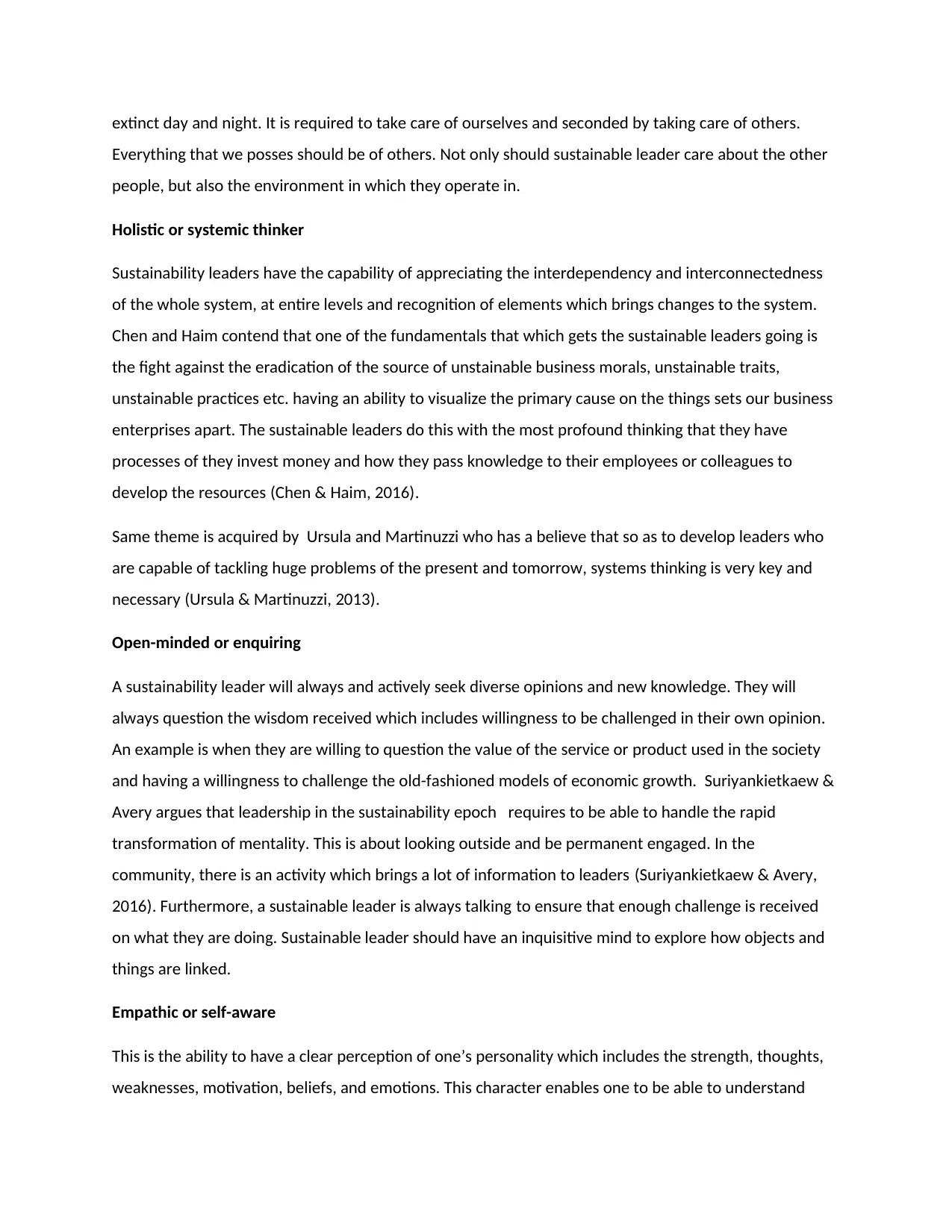
extinct day and night. It is required to take care of ourselves and seconded by taking care of others.
Everything that we posses should be of others. Not only should sustainable leader care about the other
people, but also the environment in which they operate in.
Holistic or systemic thinker
Sustainability leaders have the capability of appreciating the interdependency and interconnectedness
of the whole system, at entire levels and recognition of elements which brings changes to the system.
Chen and Haim contend that one of the fundamentals that which gets the sustainable leaders going is
the fight against the eradication of the source of unstainable business morals, unstainable traits,
unstainable practices etc. having an ability to visualize the primary cause on the things sets our business
enterprises apart. The sustainable leaders do this with the most profound thinking that they have
processes of they invest money and how they pass knowledge to their employees or colleagues to
develop the resources (Chen & Haim, 2016).
Same theme is acquired by Ursula and Martinuzzi who has a believe that so as to develop leaders who
are capable of tackling huge problems of the present and tomorrow, systems thinking is very key and
necessary (Ursula & Martinuzzi, 2013).
Open-minded or enquiring
A sustainability leader will always and actively seek diverse opinions and new knowledge. They will
always question the wisdom received which includes willingness to be challenged in their own opinion.
An example is when they are willing to question the value of the service or product used in the society
and having a willingness to challenge the old-fashioned models of economic growth. Suriyankietkaew &
Avery argues that leadership in the sustainability epoch requires to be able to handle the rapid
transformation of mentality. This is about looking outside and be permanent engaged. In the
community, there is an activity which brings a lot of information to leaders (Suriyankietkaew & Avery,
2016). Furthermore, a sustainable leader is always talking to ensure that enough challenge is received
on what they are doing. Sustainable leader should have an inquisitive mind to explore how objects and
things are linked.
Empathic or self-aware
This is the ability to have a clear perception of one’s personality which includes the strength, thoughts,
weaknesses, motivation, beliefs, and emotions. This character enables one to be able to understand
Everything that we posses should be of others. Not only should sustainable leader care about the other
people, but also the environment in which they operate in.
Holistic or systemic thinker
Sustainability leaders have the capability of appreciating the interdependency and interconnectedness
of the whole system, at entire levels and recognition of elements which brings changes to the system.
Chen and Haim contend that one of the fundamentals that which gets the sustainable leaders going is
the fight against the eradication of the source of unstainable business morals, unstainable traits,
unstainable practices etc. having an ability to visualize the primary cause on the things sets our business
enterprises apart. The sustainable leaders do this with the most profound thinking that they have
processes of they invest money and how they pass knowledge to their employees or colleagues to
develop the resources (Chen & Haim, 2016).
Same theme is acquired by Ursula and Martinuzzi who has a believe that so as to develop leaders who
are capable of tackling huge problems of the present and tomorrow, systems thinking is very key and
necessary (Ursula & Martinuzzi, 2013).
Open-minded or enquiring
A sustainability leader will always and actively seek diverse opinions and new knowledge. They will
always question the wisdom received which includes willingness to be challenged in their own opinion.
An example is when they are willing to question the value of the service or product used in the society
and having a willingness to challenge the old-fashioned models of economic growth. Suriyankietkaew &
Avery argues that leadership in the sustainability epoch requires to be able to handle the rapid
transformation of mentality. This is about looking outside and be permanent engaged. In the
community, there is an activity which brings a lot of information to leaders (Suriyankietkaew & Avery,
2016). Furthermore, a sustainable leader is always talking to ensure that enough challenge is received
on what they are doing. Sustainable leader should have an inquisitive mind to explore how objects and
things are linked.
Empathic or self-aware
This is the ability to have a clear perception of one’s personality which includes the strength, thoughts,
weaknesses, motivation, beliefs, and emotions. This character enables one to be able to understand
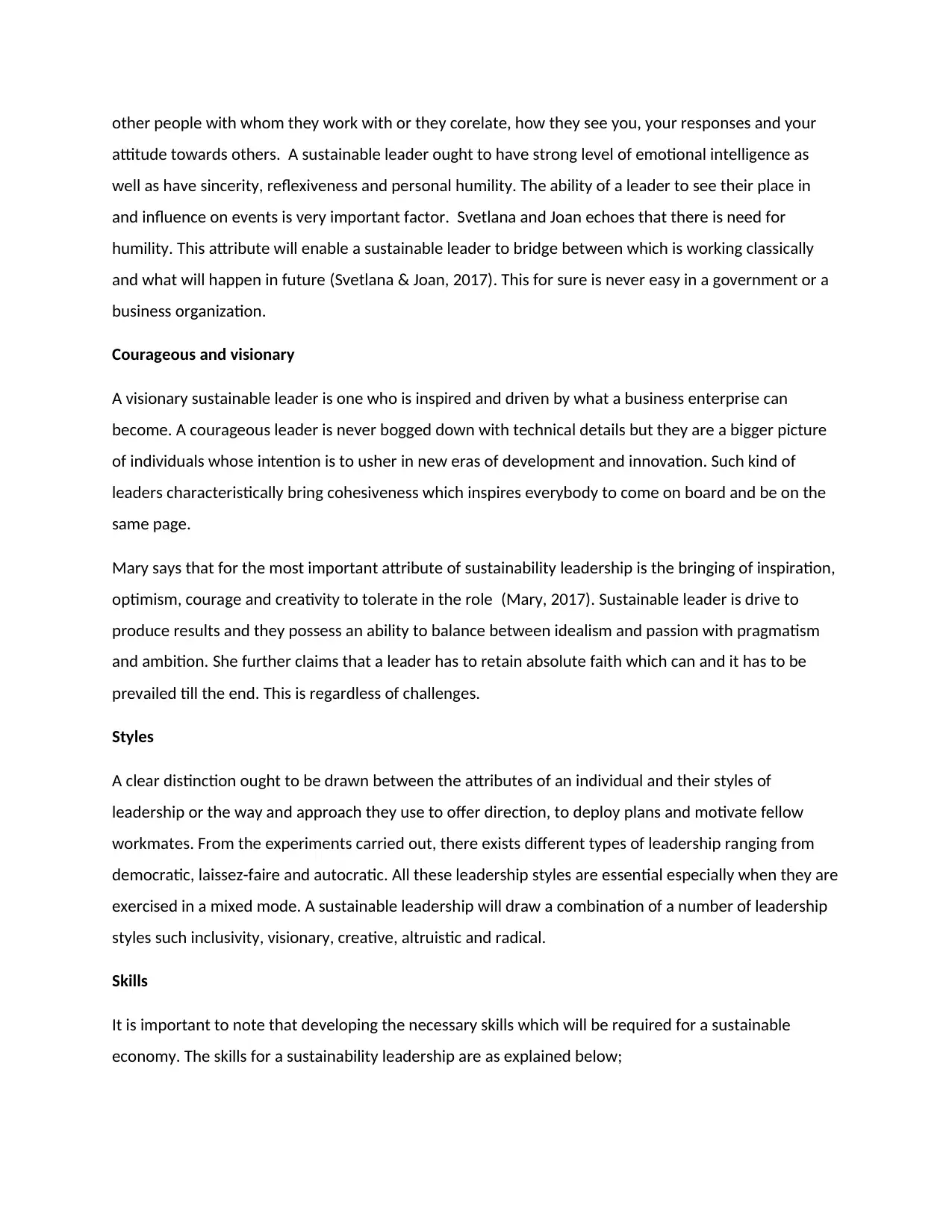
other people with whom they work with or they corelate, how they see you, your responses and your
attitude towards others. A sustainable leader ought to have strong level of emotional intelligence as
well as have sincerity, reflexiveness and personal humility. The ability of a leader to see their place in
and influence on events is very important factor. Svetlana and Joan echoes that there is need for
humility. This attribute will enable a sustainable leader to bridge between which is working classically
and what will happen in future (Svetlana & Joan, 2017). This for sure is never easy in a government or a
business organization.
Courageous and visionary
A visionary sustainable leader is one who is inspired and driven by what a business enterprise can
become. A courageous leader is never bogged down with technical details but they are a bigger picture
of individuals whose intention is to usher in new eras of development and innovation. Such kind of
leaders characteristically bring cohesiveness which inspires everybody to come on board and be on the
same page.
Mary says that for the most important attribute of sustainability leadership is the bringing of inspiration,
optimism, courage and creativity to tolerate in the role (Mary, 2017). Sustainable leader is drive to
produce results and they possess an ability to balance between idealism and passion with pragmatism
and ambition. She further claims that a leader has to retain absolute faith which can and it has to be
prevailed till the end. This is regardless of challenges.
Styles
A clear distinction ought to be drawn between the attributes of an individual and their styles of
leadership or the way and approach they use to offer direction, to deploy plans and motivate fellow
workmates. From the experiments carried out, there exists different types of leadership ranging from
democratic, laissez-faire and autocratic. All these leadership styles are essential especially when they are
exercised in a mixed mode. A sustainable leadership will draw a combination of a number of leadership
styles such inclusivity, visionary, creative, altruistic and radical.
Skills
It is important to note that developing the necessary skills which will be required for a sustainable
economy. The skills for a sustainability leadership are as explained below;
attitude towards others. A sustainable leader ought to have strong level of emotional intelligence as
well as have sincerity, reflexiveness and personal humility. The ability of a leader to see their place in
and influence on events is very important factor. Svetlana and Joan echoes that there is need for
humility. This attribute will enable a sustainable leader to bridge between which is working classically
and what will happen in future (Svetlana & Joan, 2017). This for sure is never easy in a government or a
business organization.
Courageous and visionary
A visionary sustainable leader is one who is inspired and driven by what a business enterprise can
become. A courageous leader is never bogged down with technical details but they are a bigger picture
of individuals whose intention is to usher in new eras of development and innovation. Such kind of
leaders characteristically bring cohesiveness which inspires everybody to come on board and be on the
same page.
Mary says that for the most important attribute of sustainability leadership is the bringing of inspiration,
optimism, courage and creativity to tolerate in the role (Mary, 2017). Sustainable leader is drive to
produce results and they possess an ability to balance between idealism and passion with pragmatism
and ambition. She further claims that a leader has to retain absolute faith which can and it has to be
prevailed till the end. This is regardless of challenges.
Styles
A clear distinction ought to be drawn between the attributes of an individual and their styles of
leadership or the way and approach they use to offer direction, to deploy plans and motivate fellow
workmates. From the experiments carried out, there exists different types of leadership ranging from
democratic, laissez-faire and autocratic. All these leadership styles are essential especially when they are
exercised in a mixed mode. A sustainable leadership will draw a combination of a number of leadership
styles such inclusivity, visionary, creative, altruistic and radical.
Skills
It is important to note that developing the necessary skills which will be required for a sustainable
economy. The skills for a sustainability leadership are as explained below;
⊘ This is a preview!⊘
Do you want full access?
Subscribe today to unlock all pages.

Trusted by 1+ million students worldwide
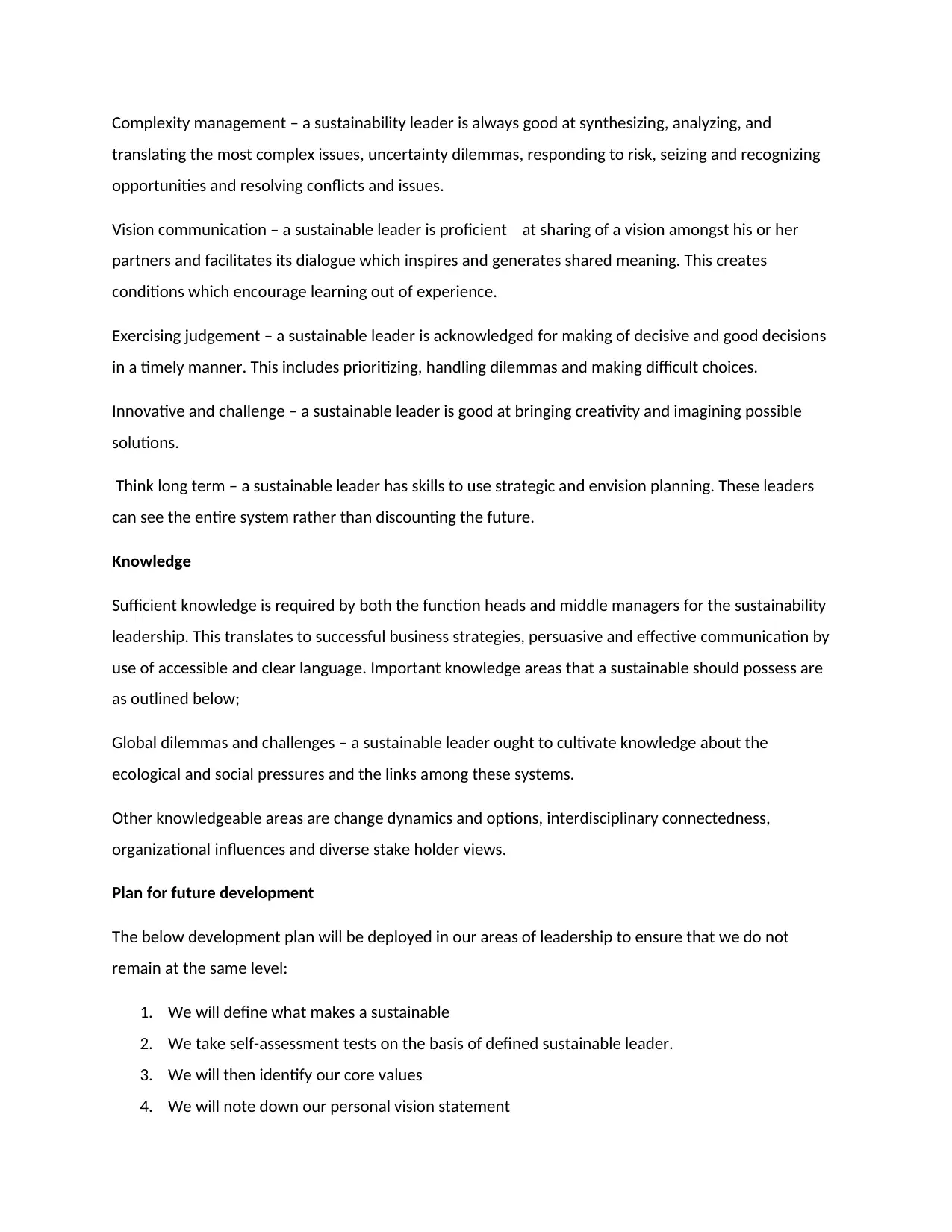
Complexity management – a sustainability leader is always good at synthesizing, analyzing, and
translating the most complex issues, uncertainty dilemmas, responding to risk, seizing and recognizing
opportunities and resolving conflicts and issues.
Vision communication – a sustainable leader is proficient at sharing of a vision amongst his or her
partners and facilitates its dialogue which inspires and generates shared meaning. This creates
conditions which encourage learning out of experience.
Exercising judgement – a sustainable leader is acknowledged for making of decisive and good decisions
in a timely manner. This includes prioritizing, handling dilemmas and making difficult choices.
Innovative and challenge – a sustainable leader is good at bringing creativity and imagining possible
solutions.
Think long term – a sustainable leader has skills to use strategic and envision planning. These leaders
can see the entire system rather than discounting the future.
Knowledge
Sufficient knowledge is required by both the function heads and middle managers for the sustainability
leadership. This translates to successful business strategies, persuasive and effective communication by
use of accessible and clear language. Important knowledge areas that a sustainable should possess are
as outlined below;
Global dilemmas and challenges – a sustainable leader ought to cultivate knowledge about the
ecological and social pressures and the links among these systems.
Other knowledgeable areas are change dynamics and options, interdisciplinary connectedness,
organizational influences and diverse stake holder views.
Plan for future development
The below development plan will be deployed in our areas of leadership to ensure that we do not
remain at the same level:
1. We will define what makes a sustainable
2. We take self-assessment tests on the basis of defined sustainable leader.
3. We will then identify our core values
4. We will note down our personal vision statement
translating the most complex issues, uncertainty dilemmas, responding to risk, seizing and recognizing
opportunities and resolving conflicts and issues.
Vision communication – a sustainable leader is proficient at sharing of a vision amongst his or her
partners and facilitates its dialogue which inspires and generates shared meaning. This creates
conditions which encourage learning out of experience.
Exercising judgement – a sustainable leader is acknowledged for making of decisive and good decisions
in a timely manner. This includes prioritizing, handling dilemmas and making difficult choices.
Innovative and challenge – a sustainable leader is good at bringing creativity and imagining possible
solutions.
Think long term – a sustainable leader has skills to use strategic and envision planning. These leaders
can see the entire system rather than discounting the future.
Knowledge
Sufficient knowledge is required by both the function heads and middle managers for the sustainability
leadership. This translates to successful business strategies, persuasive and effective communication by
use of accessible and clear language. Important knowledge areas that a sustainable should possess are
as outlined below;
Global dilemmas and challenges – a sustainable leader ought to cultivate knowledge about the
ecological and social pressures and the links among these systems.
Other knowledgeable areas are change dynamics and options, interdisciplinary connectedness,
organizational influences and diverse stake holder views.
Plan for future development
The below development plan will be deployed in our areas of leadership to ensure that we do not
remain at the same level:
1. We will define what makes a sustainable
2. We take self-assessment tests on the basis of defined sustainable leader.
3. We will then identify our core values
4. We will note down our personal vision statement
Paraphrase This Document
Need a fresh take? Get an instant paraphrase of this document with our AI Paraphraser
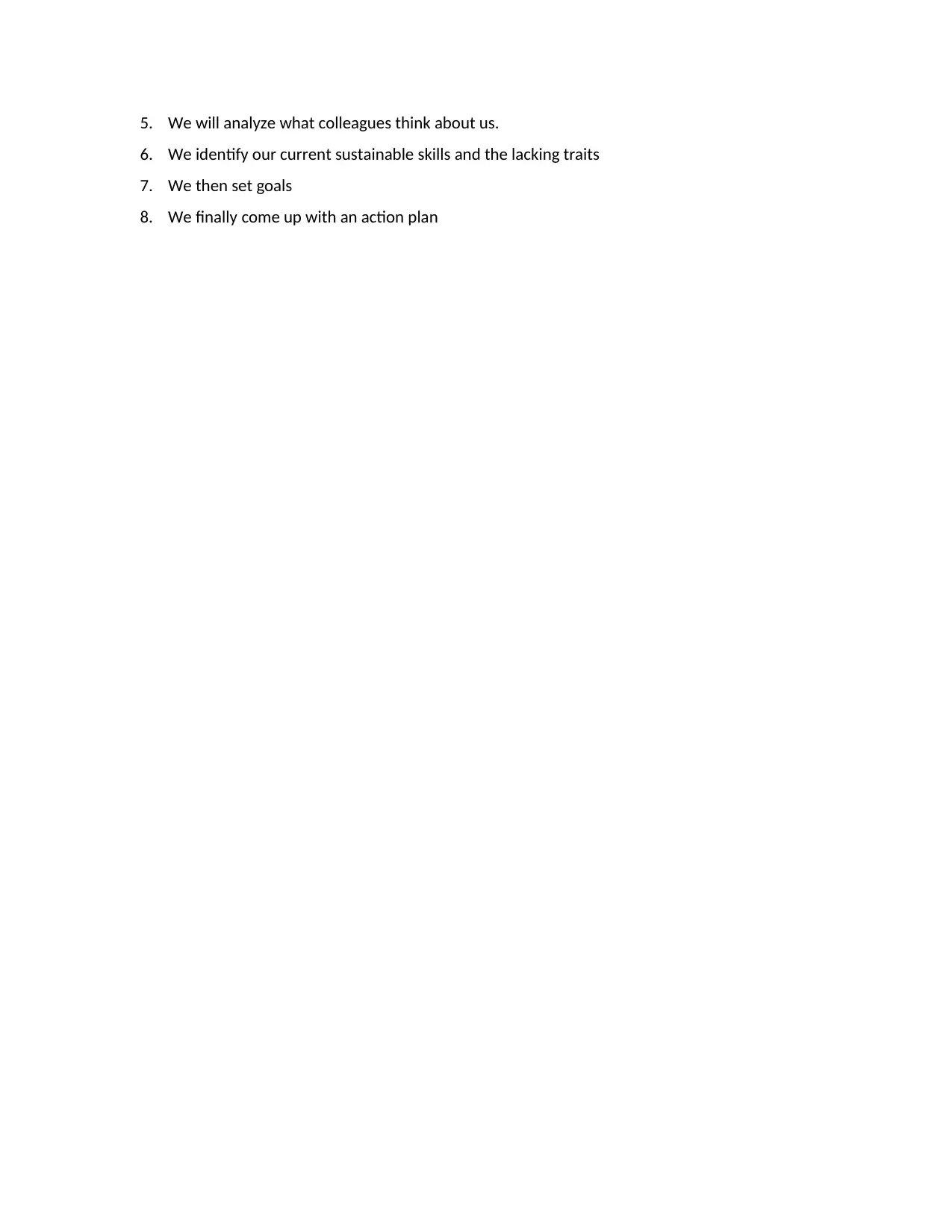
5. We will analyze what colleagues think about us.
6. We identify our current sustainable skills and the lacking traits
7. We then set goals
8. We finally come up with an action plan
6. We identify our current sustainable skills and the lacking traits
7. We then set goals
8. We finally come up with an action plan
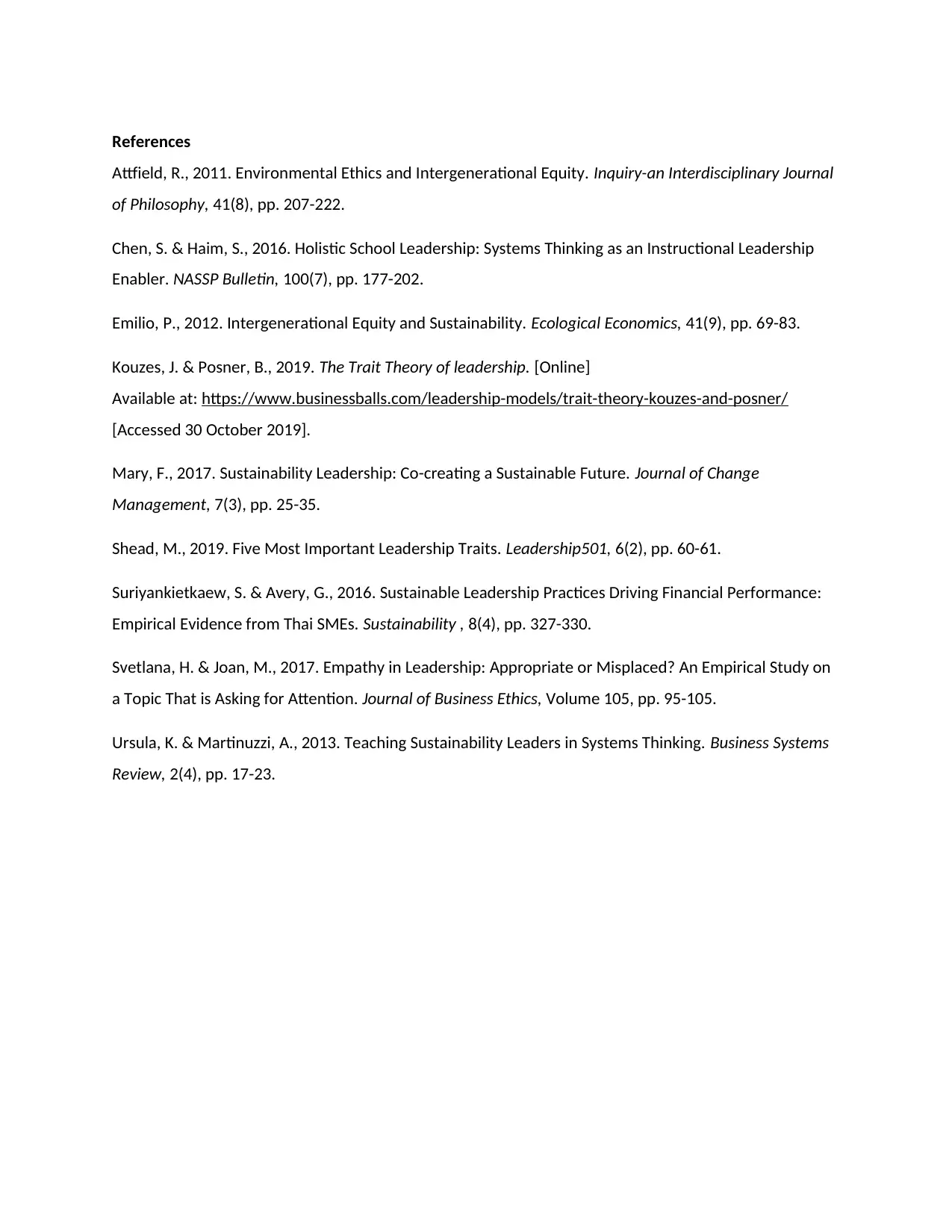
References
Attfield, R., 2011. Environmental Ethics and Intergenerational Equity. Inquiry-an Interdisciplinary Journal
of Philosophy, 41(8), pp. 207-222.
Chen, S. & Haim, S., 2016. Holistic School Leadership: Systems Thinking as an Instructional Leadership
Enabler. NASSP Bulletin, 100(7), pp. 177-202.
Emilio, P., 2012. Intergenerational Equity and Sustainability. Ecological Economics, 41(9), pp. 69-83.
Kouzes, J. & Posner, B., 2019. The Trait Theory of leadership. [Online]
Available at: https://www.businessballs.com/leadership-models/trait-theory-kouzes-and-posner/
[Accessed 30 October 2019].
Mary, F., 2017. Sustainability Leadership: Co-creating a Sustainable Future. Journal of Change
Management, 7(3), pp. 25-35.
Shead, M., 2019. Five Most Important Leadership Traits. Leadership501, 6(2), pp. 60-61.
Suriyankietkaew, S. & Avery, G., 2016. Sustainable Leadership Practices Driving Financial Performance:
Empirical Evidence from Thai SMEs. Sustainability , 8(4), pp. 327-330.
Svetlana, H. & Joan, M., 2017. Empathy in Leadership: Appropriate or Misplaced? An Empirical Study on
a Topic That is Asking for Attention. Journal of Business Ethics, Volume 105, pp. 95-105.
Ursula, K. & Martinuzzi, A., 2013. Teaching Sustainability Leaders in Systems Thinking. Business Systems
Review, 2(4), pp. 17-23.
Attfield, R., 2011. Environmental Ethics and Intergenerational Equity. Inquiry-an Interdisciplinary Journal
of Philosophy, 41(8), pp. 207-222.
Chen, S. & Haim, S., 2016. Holistic School Leadership: Systems Thinking as an Instructional Leadership
Enabler. NASSP Bulletin, 100(7), pp. 177-202.
Emilio, P., 2012. Intergenerational Equity and Sustainability. Ecological Economics, 41(9), pp. 69-83.
Kouzes, J. & Posner, B., 2019. The Trait Theory of leadership. [Online]
Available at: https://www.businessballs.com/leadership-models/trait-theory-kouzes-and-posner/
[Accessed 30 October 2019].
Mary, F., 2017. Sustainability Leadership: Co-creating a Sustainable Future. Journal of Change
Management, 7(3), pp. 25-35.
Shead, M., 2019. Five Most Important Leadership Traits. Leadership501, 6(2), pp. 60-61.
Suriyankietkaew, S. & Avery, G., 2016. Sustainable Leadership Practices Driving Financial Performance:
Empirical Evidence from Thai SMEs. Sustainability , 8(4), pp. 327-330.
Svetlana, H. & Joan, M., 2017. Empathy in Leadership: Appropriate or Misplaced? An Empirical Study on
a Topic That is Asking for Attention. Journal of Business Ethics, Volume 105, pp. 95-105.
Ursula, K. & Martinuzzi, A., 2013. Teaching Sustainability Leaders in Systems Thinking. Business Systems
Review, 2(4), pp. 17-23.
⊘ This is a preview!⊘
Do you want full access?
Subscribe today to unlock all pages.

Trusted by 1+ million students worldwide
1 out of 9
Related Documents
Your All-in-One AI-Powered Toolkit for Academic Success.
+13062052269
info@desklib.com
Available 24*7 on WhatsApp / Email
![[object Object]](/_next/static/media/star-bottom.7253800d.svg)
Unlock your academic potential
Copyright © 2020–2025 A2Z Services. All Rights Reserved. Developed and managed by ZUCOL.





